JILPT Research Report No.195
Hiring and Workplace Assimilation at SMEs
March 31, 2017
Summary
Research Objective
As economies become increasingly global and competition intensifies, one of the most important issues when considering the future of Japan’s economy is how to maintain or increase the stability of employment. As small and medium sized enterprises (SMEs) employ more than half of all workers in Japan, making them more active is a particularly significant issue. This research examines the present situation of management in SMEs, in terms of personnel management, in order to study effective ways of supporting them. Although “personnel management in SMEs” covers a very wide range, this research will investigate actual situations of their personnel recruitment and hiring management. The main focus of this investigation will be on mid-career hiring, given the expectation of increased fluidity between external and internal labor market in future.
Research Method
Analysis of questionnaire survey results
Main Findings
- Table 1 shows trends in hiring and quitting during the survey period (2011-13), in terms of average numbers of workers. During that period, 4.92 workers were newly hired (meaning that it was their first job) on average, but 2.25 of the same quit their jobs. Similarly, 12.92 workers were hired in mid-career (meaning that it was not their first job), but 11.01 of the same quit.
Table 1. Average numbers of workers hired or quitting (persons)

The ratio of mid-career hiring tended to be greater in more recently established companies, in smaller-scale companies, and, in terms of industries, mainly in “Medical, health care and welfare,” “Finance and insurance” and “Transport and postal activities,” among others. In “Medical, health care and welfare” and “Transport and postal activities,” the job quitting ratio was also high.
- On the policies behind mid-career hiring and training, a common rationale is that “Experienced employees are hired in mid-career in order not to cost in training” or that “When hiring experienced employees, skill development after hiring would depend on self-accountability.” The results, however, proved that about one in four companies in the sample placed emphasis on the potential of mid-career recruits when hiring, and that more than half of the companies saw the responsibility for skill development after hiring as lying with the companies themselves (see Figure 1).
Figure 1. Policies on mid-career hiring, responsibility for training (%)
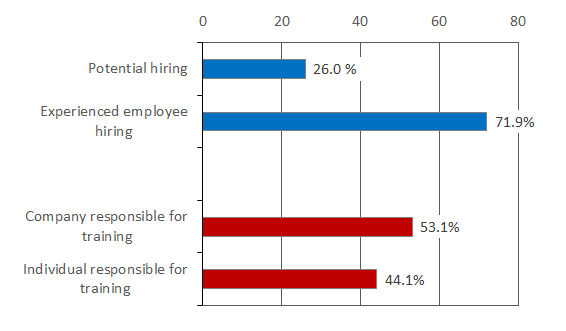
In terms of policies on human resource management as a whole, companies that “prioritize new graduate recruitment, while responsibility for employees’ skill development lies with the company” (about 30% of the total) are more positive in efforts toward skill development or employee welfare than those that “prioritize mid-career hiring, while responsibility for employees’ skill development lies with the individual” (just over 20%). Employees also have a better perception of the relationship with the company and are more positive if they feel that their employer “prioritizes new graduate hiring and adopts a long-term view of investment in employees’ skill development.”
- In terms of mid-career hiring to management posts, actual hiring figures show that not many companies practice mid-career hiring to the management post level; in terms of industries, they tend rather to be relatively new companies in construction or information and communications, or companies that target scale expansion and offer relatively high wage levels.
As policies on securing management posts, more companies practice “internal recruitment, namely, filling a post by a worker who has been working at the same company for their whole life” (around 70%) compared to those that “recruit from external sources” (just under 30%). The former enjoys a high ratio even in relatively small companies (see Figure 2).
Figure 2. Policy on securing management staff: Internally vs. Externally recruited
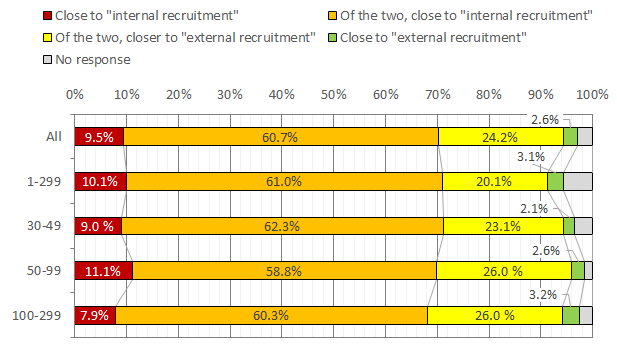
Even in the “internal recruitment” type, mid-career hiring is practiced for management posts. A tendency to prioritize “Japanese-style employment practices” can be seen. There is also a tendency to require “strong acumen, leadership, and skills in specific field” of hired personnel, and to prioritize hiring routes such as “introductions by friends and acquaintances” compared with the routes through public employment center. Hiring is quite often conditional upon high wages, managerial positions and other relatively high-level employment terms. The problem is that “human resources with the required ability hardly be found.”
- On ideas for new recruits to fit in with their new workplace, firstly, their intention to keep working for their new employer over the long-term tended to differ, depending on whether or not they had experienced “suffering a setback or worries” immediately after entering the company, as shown in Figure 3.
Since it would conceivably take a new recruit longer to adapt successfully to a new company after a job change if some kind of difficulty is experienced, companies need to apply management measures to ensure this kind of thing does not occur. There is no particularly large difference, however, it has been pointed out that specific measures such as “giving support for acceptance,” “creating opportunities for mid-career recruits to observe the workplace,” or “assigning to workplaces where there are sufficient personnel for a while after hiring” are important for ensuring smooth initial workplace assimilation and adaptation.
Figure 3. Experience of suffering problems / a setback vs. Intention to keep working long term
The possibility is also suggested that, if there are no such difficulties, mid-career recruits are encouraged to sense the importance of their own skills and knowledge. If new recruits sense a workplace atmosphere in which they themselves can feel important, it could be expected to have the effect of reducing difficulties to carry on. As such, attention should be paid to this kind of the point.
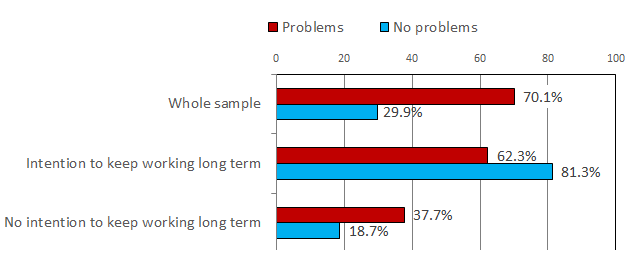
- On the types of job change by the consistency and skill development of job-changers, types of job change were studied from survey responses concerning differences or similarities in job and industry compared to the previous job. These were the following four types, (i) “the consistent type-same industry, same job,” (26.5% of the respondents), (ii) “the same job type-different industry, same or similar job” (24.5%), (iii) “the same industry type-same industry, different job” (2.3%), and (iv) “the divergent type-different industry, different job,”(36.6%) (see Figure 4).
Figure 4. Job change types (%)
As reasons for changing jobs, “I can make use of my previous experience.” and “I can express my own skills.” were most commonly cited in the consistent type, while working conditions were most commonly given as the reason in the divergent type. Among those changing jobs from different industries, many take the Hello Work (public employment security offices) route, while those moving within the same industry are most commonly “Introduced by someone working in the same industry.”
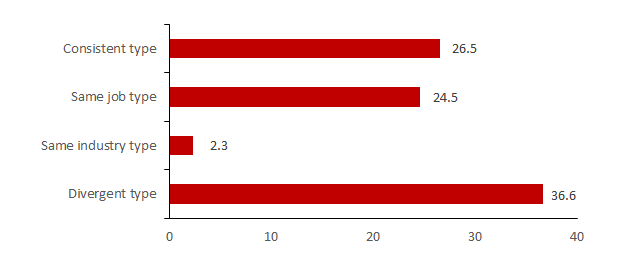
The majority of those changing jobs from different industries responded that they had “Gathered information from the Internet and other sources,” while a large proportion of those in the same job type responded that they had “Used private employment agency.” Changing jobs from different industries seems to be more beset with difficulties.
In terms of expressing skills, those working in the same job gave a high ratio of positive responses on whether or not skills acquired in previous workplaces could be used after the change (see Figure 5).Figure 5. Utilization in the current job of skills acquired in the previous workplace (%)
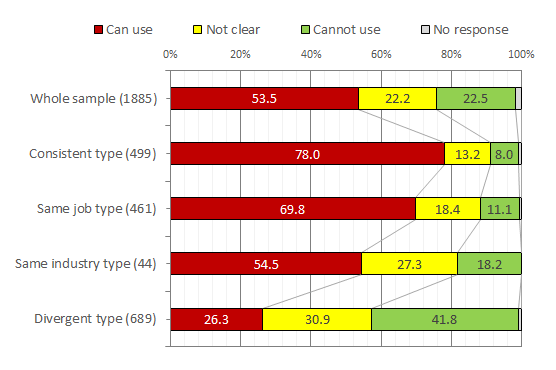
- On studying the characteristics of job-changers in specific job groups, namely, those currently responsible for managerial work and working no more than three years for their current employer (“skilled employees in charge of management work”), they accounted for just under 40% of those currently in charge of managerial work.
Although there was not such a great difference compared to other mid-career recruits, in terms of industry, these were commonly seen in manufacturing, wholesale and retail trade, construction and others. A particular difference was seen in eating and drinking services. In their choices of employers, they choose workplaces where it is comfortable to work at, in the sense that they can draw on their own skills and they share the principles of the owners. Many of them feel that they can let their careers develop as they wish. Of all mid-career recruits, they are the ones who have a clear career vision, live independent professional lives, and place more emphasis on motivation.
Policy Implications
- To support companies in developing systems for eliminating “suffering setbacks” experienced by job-changers at the onboarding and assimilation process, it is important to study ideas for reducing mismatches when hiring, by making companies aware that basic management measures are useful.
- For job-changers, it has great meaning to provide information pertaining to patterns of job-change as well as subsequent situations and tendencies. Considering the performance after a job change, it is crucial to stay in the same type of job before and after the change. For those who opt for a “different” job, the stance adopted by companies for the job-changers is an important factor.
Though not particularly numerous in terms of ratios, being hired to a management post in mid-career could lead to increased opportunities for improved employment terms by changing jobs; this will also serve as useful information for job-changers.
- To be able to perform fully after a job change, the job continuity is important in the sense of staying in the same type of job before and after the change. Creating and expanding a matching system to maintain this kind of continuity is an important task. It will be worthwhile to study optimal directions for a new public-private collaboration in this regard, as well as ways of managing and using information on job seekers and companies looking for staff.
Policy Contribution
Small and medium enterprises are trying to create workplaces where there is work motivation, while improving their business performance amid a harsh competitive environment. Given the expectation of increased labor mobility in future, the outcome of this research will provide basic data for studying measures to support these enterprises in aspects of employment, and human resource management.
Contents (available only in Japanese)
- JILPT Research Report No.195 Whole text (PDF: 9.1MB)
If it takes too long to download the whole text, please access each file separately.
- Cover – Preface – Authors – Contents (PDF: 274KB)
- Chapter 1: Outline of research on “Hiring and workplace assimilation in small and medium enterprises” (PDF: 555KB)
- Chapter 2: Labor movement in small and medium enterprises (PDF: 1.3MB)
- Chapter 3: Mid-career hiring policies and skill development after hiring: Analysis pivoting on “hiring potential vs. experience” and “company responsibility vs. individual responsibility for skill development” (PDF: 1.1MB)
- Chapter 4: Mid-career hiring to management posts in small and medium enterprises: Policies on securing personnel for management posts, and realities and issues of hiring (PDF: 1.0MB)
- Chapter 5: Initial assimilation measures for smooth familiarization of mid-career hiring to their organizations (PDF: 540KB)
- Chapter 6: Types of job change to small and medium enterprises and impressive performance after the hiring (PDF: 809KB)
- Chapter 7: Characteristics of seasoned personnel responsible for managing staff (PDF: 625KB)
- Appendices: Results of simple aggregation (PDF: 1.2MB)
Research Categories
Project Research: “Research on Companies’ Employment Systems and Personnel Strategies, Improvement of the Quality of Employment through Development of Employment Rules, and Realization of Decent Work”
Subtheme: “Research project on corporate management and human resource strategies”
Research Period
April 2015 - March 2016
Authors
- Atsushi SATO
- Professor, Faculty of Lifelong Learning and Career Studies, Hosei University
- Yoshihide SANO
- Professor, Faculty of Business Administration, Hosei University
- Hideki TANAKA
- Lecturer, Aomori Public University
- Ryoji NAKAMURA
- Assistant Research Director, JILPT
- Itaru NISHIMURA
- Vice Senior Researcher, JILPT
- Makoto FUJIMOTO
- Senior Researcher, JILPT
Catergory
JILPT Research Report > Category Index > Employment / Unemployment, Working conditions / Work environment, Human resources management / Vocational skills development
Related Research
- JILPT Research Material Series No.140, “Targeting the survey on ‘hiring and retention’ in small and medium enterprises,” (2014)
- JILPT Research Series No.141, “Results of the survey on ‘hiring and retention’ in small and medium enterprises – Preliminary version,” (2015)
- JILPT Research Material Series No.172, “Outline of labor mobility in small and medium enterprises: Survey on “hiring and retention” – Interim version (2016)
JILPT Research Report at a Glance
| To view PDF files, you will need Adobe Acrobat Reader Software installed on your computer.The Adobe Acrobat Reader can be downloaded from this banner. |

